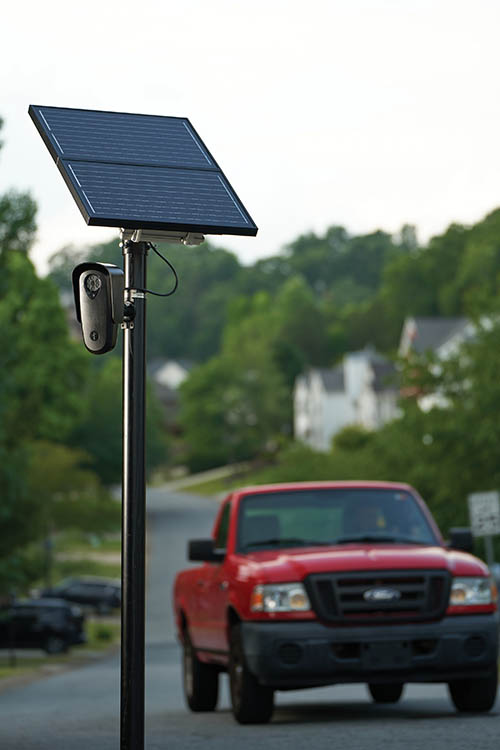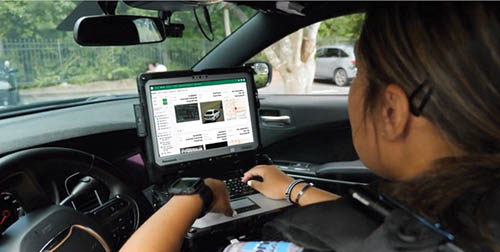— By Rich McElwain —
Enhancing retail security through license plate recognition (LPR).
In an era of rapidly evolving technology, security is a top concern for retailers to proactively protect physical assets, employees and customers from potential threats. According to the National Retail Federation’s (NRF) 2022 Retail Security Survey, retailers attributed their greatest portion of shrink — a whopping 37% — to external theft. In addition, retailers saw a 26.5% increase in Organized Retail Crime (ORC) incidents over the past year, representing $94.5 billion in losses.

The landscape of retail has shifted, and with it, the challenges associated with maintaining a safe environment. Traditional security measures have been reactive, relying on alarms, surveillance footage review and manual intervention after an incident occurs. The limitations of these methods have paved the way for advanced, proactive solutions, with license plate recognition (LPR) technology emerging as a game-changer in retail security.
License Plate Recognition
LPR camera systems are specifically calibrated to detect and recognize license plates — the most useful piece of actionable evidence needed to solve and prevent crime, as 7 in 10 crimes are committed with a vehicle, according to the International Association of Chiefs of Police. Unlike traditional video security cameras, an LPR system makes license plate and vehicle evidence easily accessible and quickly searchable. If a crime or incident of violence occurs, even without a full plate number, police or security personnel can narrow down footage based on the timeframe, vehicle color, vehicle type, make or other descriptors, such as alterations and damage. Authorities can then use this investigative evidence to quickly solve cases, strengthen prosecutions and gather intelligence to reduce future threats.
Prevent In-Store Violence
Traditional retail theft is not the only concern. Instances of significant violence in retail settings are also becoming more frequent. This trend has thrust workplace security into the limelight, underscoring the urgent need for companies to prioritize their employees’ safety. People are no longer just seeking jobs; they’re actively seeking out organizations that go the extra mile to ensure a safe environment. And that begins with a secure perimeter.

LPR cameras are installed at entry and exit points around businesses to create a virtual perimeter that detects and deters crime before it occurs. It is essential that effective deterrence starts as soon as a potential threat crosses into a property’s perimeter. Once a bad actor with a weapon enters a building, escalation can occur rapidly.
LPR cameras provide real-time alerts for potentially-dangerous or previously-identified vehicles entering a retail property, such as those belonging to repeat crime offenders, banned guests, violent terminated employees or individuals known to engage in ORC. These alerts can trigger immediate responses from law enforcement or security personnel, allowing them to assess the situation and take appropriate action swiftly, away from customers and other employees. LPR data also aids law enforcement in investigations by providing evidence.
In addition, unlike the more conventional technologies that have lost some of their deterrent value due to familiarity, LPR presents a new evidentiary capture avenue, which may elude the awareness of those with bad intentions. As a result, the mere presence of LPR cameras, augmented by clearly visible monitoring signage, can foster a perceptible reduction in criminal activity, effectively dissuading potential offenders and making parking lots safer havens for all.
Enhance Investigations
A significant challenge retailers face is organized retail crime (ORC). These coordinated efforts by criminal groups can lead to substantial financial losses and operational disruptions. Some LPR systems can help identify vehicles linked to multiple crimes or identify accomplice vehicles, like those involved in ORC.

For example, a Fortune 500 big box retailer’s Alabama storefront was experiencing acute retail shrink impacts after becoming a target for out-of-town shoplifters — especially during the holiday season. This ongoing issue led its asset protection associate to search for new solutions to help close cases and minimize losses. The retailer chose to equip its storefront with LPR cameras, in order to empower its asset protection team with actionable evidence needed to partner with local law enforcement. Not only did this enable the team to improve its case closure rate, it also acted as a deterrent for criminals.

The LPR system helped this storefront improve its case closure rate by more than 25%, bringing it to a 97% success rate. The store also cut its inventory shrinkage score by nearly 50% year-over-year. With the successful identification of suspects via the LPR camera system, the retailer was able to minimize overall losses by recovering stolen merchandise. A prominent example of this occurred when the LPR cameras aided in the identification and apprehension of an ORC group that committed a string of thefts amounting to approximately $130,000 of stolen merchandise across several stores. By providing the license plate associated with the ORC group, the APA was able to work with local law enforcement to apprehend the suspects and prevent ongoing theft from this group.
Conclusion
As the retail environment transforms, so too must the strategies employed to ensure safety and security. The emergence of LPR technology stands as a beacon of innovation, redefining the ways in which security is approached in the retail world. Its integration signifies a commitment not just to safeguarding assets, but to reshaping the very essence of security.
— Rich McElwain is a commercial solutions consultant for Flock Safety, an all-in-one technology solution, with more than 10 years of experience in law enforcement.

